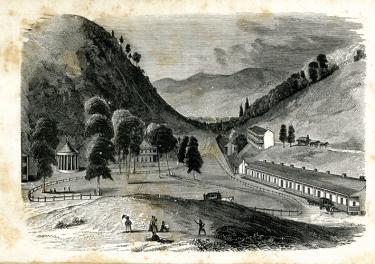The Mineral Springs Of Western Virginia by William Burke

The frontispiece is from A Visit to the Red Sulphur Spring of Virginia, during the Summer of 1837 by Henry Huntt published in Boston by Dutton and Wentworth in 1839.
This exhibit is inspired by The Mineral Springs of Western Virginia by William Burke, the first volume purchased by the Weaver Family Endowed Rare Book and Medical Materials Fund. Published in 1846, the book describes the setting and development of eleven springs in what are now Virginia and West Virginia. Dr. Burke, a one-time owner and resident physician at Red Sulphur Springs, remarks on the usefulness of the various mineral waters in certain diseases as well as contraindications to their use. The springs range from those that are well known today such as the White Sulphur Springs, currently the Greenbrier resort in West Virginia, to the Blue Sulphur Springs, once able to accommodate several hundred people and now represented by a lone Greek Revival pavilion in the middle of a field near Smoot, West Virginia.
Selected information from Burke’s book is enhanced by dozens of images and transcriptions of nineteenth-century letters and documents from the University of Virginia’s Special Collections Library. These reflect the experiences of visitors to the springs. For example, one writer finds his health “greatly improved” while another describes himself as “much weaker & more reduced than I ever was before.” Assessments of the various establishments and clientele vary from an “exceedingly pleasant place” with “many pleasant acquaintances” to “dull and uninteresting” and “that sink hole of extravagance, gambling & vice for many young & unmarried men.”
In addition to the written documents, ten of the eleven springs are illustrated by etchings or paintings from the nineteenth century. Links to relevant Web sites provide more recent information such as National Register of Historic Places data, photos, and current use. A Google map gives the location of the springs and recent photos.